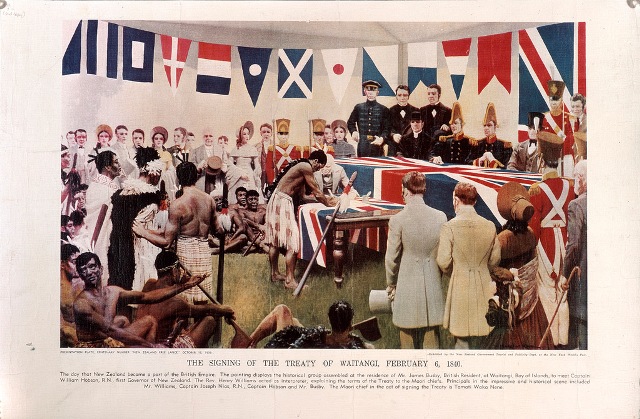 “We commonly heard references to the Treaty of Waitangi (the Treaty) in the context of republicanism during our fieldwork.” [Photo: Archive New Zealand]
“We commonly heard references to the Treaty of Waitangi (the Treaty) in the context of republicanism during our fieldwork.” [Photo: Archive New Zealand]
[A full version of this article appears in a special edition of The Round Table: Commonwealth Journal of International Affairs on The Crown and Constitutional Reform.]
My challenge to republicans is this: to what degree does republicanism construct the very nation they believe a ‘Kiwi’ head of state would reflect? What is a Kiwi anyway? If a move to a republic is about ‘cutting the colonial ties’, this poses the question: whose colonial ties are being cut? Is republicanism about moving to a truly postcolonial political system, or is it a nation-building project that potentially marginalises other forms of national identity? To contemplate shifting the locus of sovereignty from the monarch to a local head of state, without resolving wider issues pertaining to sovereignty itself, fails to truly escape the colonialism that republicans relegate to the past.
Conclusion
While New Zealand Republic and the Constitution for Aotearoa New Zealand project are guided by different logics, common to both is a desire to construct constitutional arrangements that reflect what they see as national identity. This is based on understanding that the British royal family are incapable of embodying what it means to be a Kiwi. While republican rhetoric is stocked with emotive claims and legal explanations, I found that republicans had given less thought to the symbolic dimensions of their project. They deemed symbolic issues to be inconsequential to their success. However, symbols are hard to invent. If New Zealanders cannot decide on a new flag, what about the symbolism that surrounds the head of state? What about a replacement for the Crown?
Moreover, the Crown is much more than the Queen or the royal family; it is a symbol that is deeply embedded in political practice and history. It condenses a range of meanings – legitimacy, sovereignty, due process – and through association with it, a range of institutions and office holders are unified into an abstract state-like entity. It allows those in the political system – its officials, experts and politicians – to imagine themselves as a cohesive community, pursuing goals on behalf of the public. It is a symbol of authority, and those who bear it, or speak on its behalf, carry a unique form of legitimacy. It also establishes the continuity of that community; the Crown maintains order in the political cosmology – one that transcends leadership struggles, abuses of power and the life cycles of public servants.
I discussed with Geoff McLay, a legal scholar who worked as a law commissioner from 2010 to 2015, the many roles of the Crown in legal and political worlds. After discussing the nuances of defining the Crown in legislation, he stepped back into a more philosophical mode, sharing his thoughts about a good friend of his, who is high church Anglican (what McLay referred to as the ‘smells-and-bells’ church). Though this friend was theologically very liberal, the precision of traditional religious ritual was of the utmost importance to him. McLay told me, ‘You could do away with those symbols and say, “nothing is lost, I don’t believe in that anymore, they’re just symbols”. But actually, something would be lost, that sense of communication, of joint language’. On one hand, he referred to his friend, for whom the rituals inherited from the past serve to provide spiritual solutions to existential crises in the present. But he was also referring to the symbol of the Crown. Sure, McLay was inferring, we could replace the Crown, the monarchy and all the royal ritual, but not without losing something that may be difficult to live without. Despite my personal republican attitudes, I must agree somewhat with McLay here. The Crown is a unique political symbol, capable of being everyone and no one. One can speak on its behalf while denying all responsibility for its actions. It can apologise for its past, while disguising its neo-colonial form today. I am sceptical as to whether one could ever replace it with something that has the same complexity of meaning as well as the same cultural authority.
I am by no means suggesting that republicanism in New Zealand is impossible or undesirable. However, I do challenge the notion that republicanism is inevitable. Transition to a republic is not a teleological certainty, the final realisation of nationhood that will emerge naturally though an informative campaign and rational deliberation. Rather, it requires a serious discussion around what the nation is in the first place, as well as what would replace the Crown in legislation and political practice. That is, the republican project must engage more thoroughly with the symbolic dimension of the constitution, rather than reducing the symbolic implications of republican reform to ‘dotting the “i”s and crossing the “t”s’.
[Jai Patel is with the School of Social and Political Sciences, University of Melbourne]



